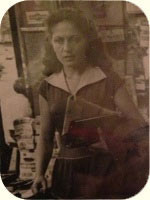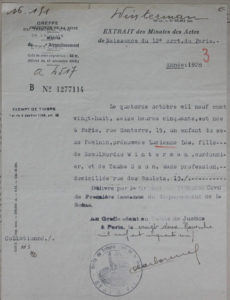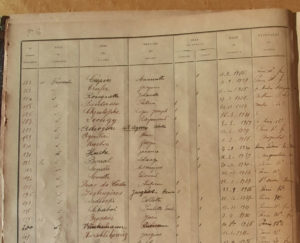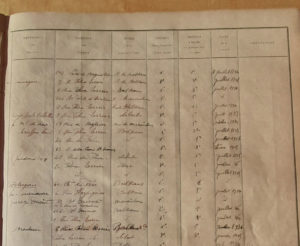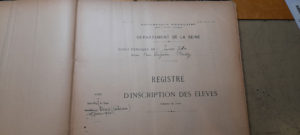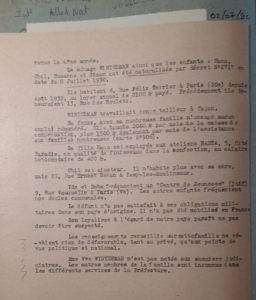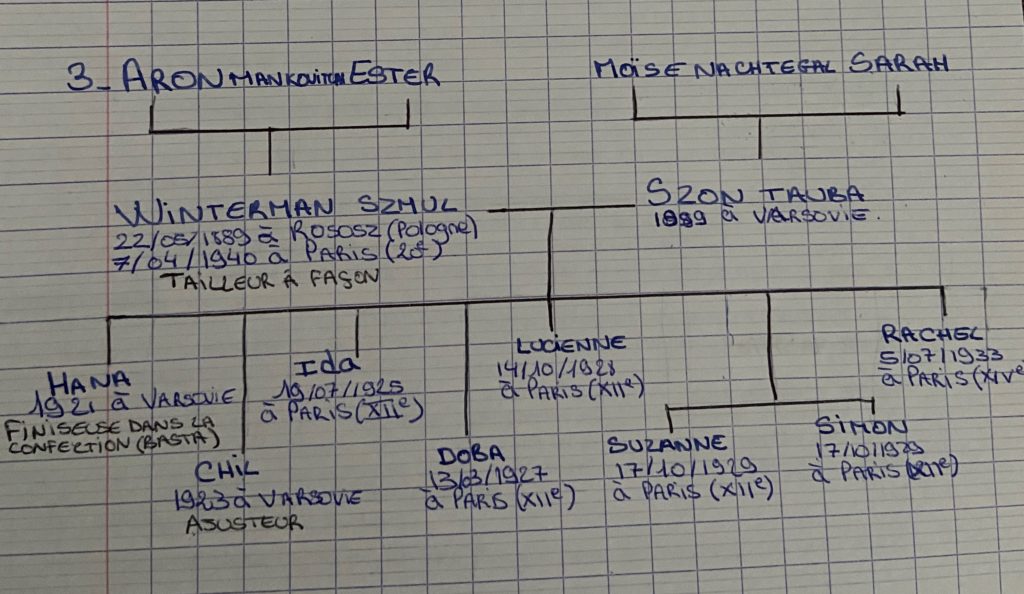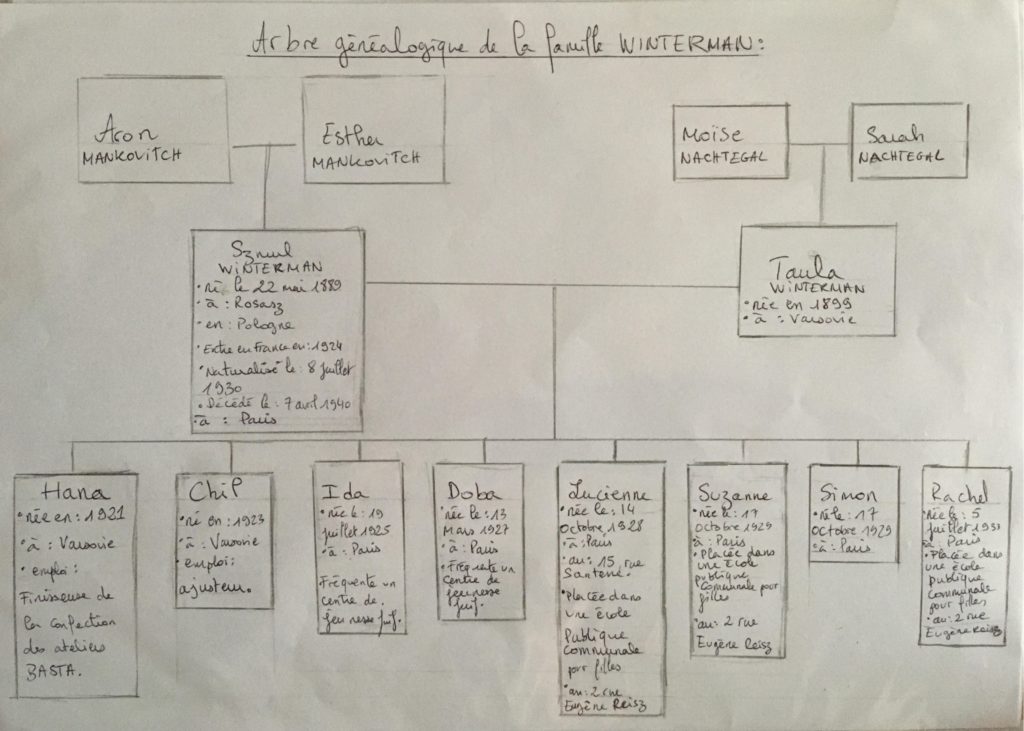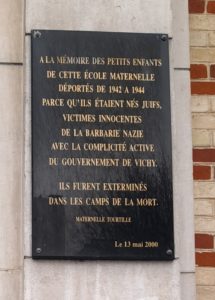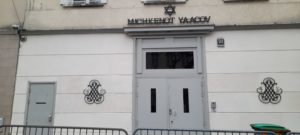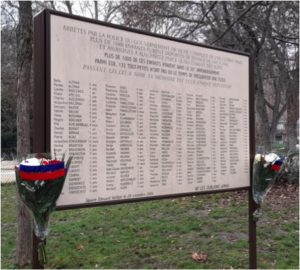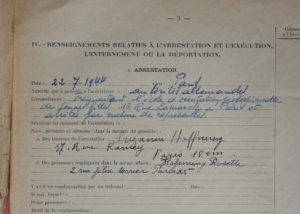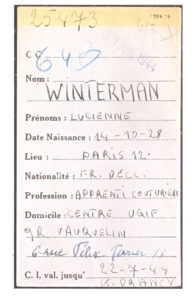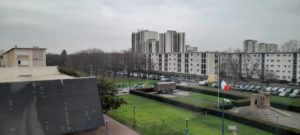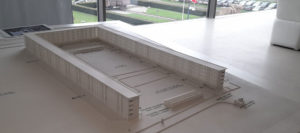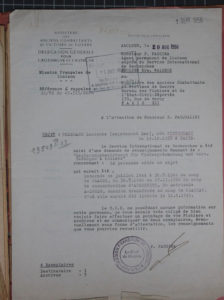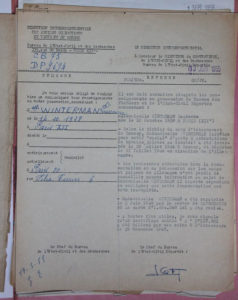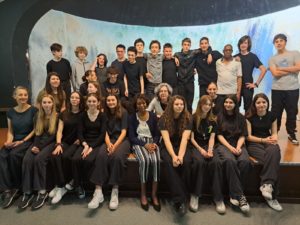Lucienne WINTERMAN
A teenager from our neighborhood
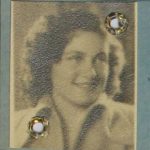 Here are two photos of Lucienne Winterman. She was 16 years old when she was deported. The first photo shows her in the street, wearing a dress and carrying a handbag. This photo comes from the MemorialGenWeb website, and was sent to us by Sabine Winterman. The second is a portrait photo, possibly from an identity card.
Here are two photos of Lucienne Winterman. She was 16 years old when she was deported. The first photo shows her in the street, wearing a dress and carrying a handbag. This photo comes from the MemorialGenWeb website, and was sent to us by Sabine Winterman. The second is a portrait photo, possibly from an identity card.
Lucienne’s birth certificate.
Victims of Contemporary Conflicts Archives Division of the Ministry of Defense Historical Service.
Lucienne Winterman’s birth certificate includes a great deal of information about her family (surnames, first names, parents’ occupations), her birth (date, place, time, parents) and about her (gender, full name). It shows that she was born on October 14, 1928 at 4:50 p.m. at 15 rue Santerre in Paris.
This document comes from the État Civil, the French State registry. The numerous stamps and annotations on it bear witness to this.
Her mother was Tauba Szon, who was not working at the time. Her father was Szmul Mordko Winterman, a shoemaker and shoe repairer.
A number of addresses are mentioned on it. These include 15 rue Santerre, in the 12th district of Paris, which was the Rothschild Hospital. During the First World War, it was used to treat where the wounded, and was bombed during a German air raid. During the German occupation in the Second World War, it was used as a detention center. It was originally built as a hospital for Jewish patients.
Lucienne was born there in 1928.
Then there is 13 rue des Boulets in the 11th district of Paris. This was the Winterman family home.
Pages from the 1936 census of Paris.
Paris Archives.
Pages from the 1936 census of Paris relating to 6 rue Félix Terrier, where Lucienne Winterman and her family were living at the time, include columns with the following details: Street name, House number Surname, Forename, Year of birth, Place of birth (such as the Corrèze department for some people and Poland for Szmul Winterman), Nationality (the Wintermans are listed as French), Marital status (M for married, C for single), Status in relation to the head of household (ch for head of household, ép for wife, F for son or daughter), Profession and Place of work. The father, Szmul Winterman, originally from Poland and now a French citizen, was the only person in the household who was working. He was a self-employed embroiderer in the 18th district of Paris. His trade involved designing and making clothes and other articles from fabric.
His wife, either Tauba or Taula, was a homemaker. Their eight children (six girls and two boys) were all from Poland and all single. Denise, Suzanne and Simon’s names are crossed out and noted as ABS, meaning absent.
This is one of the first family trees that we were able to put together: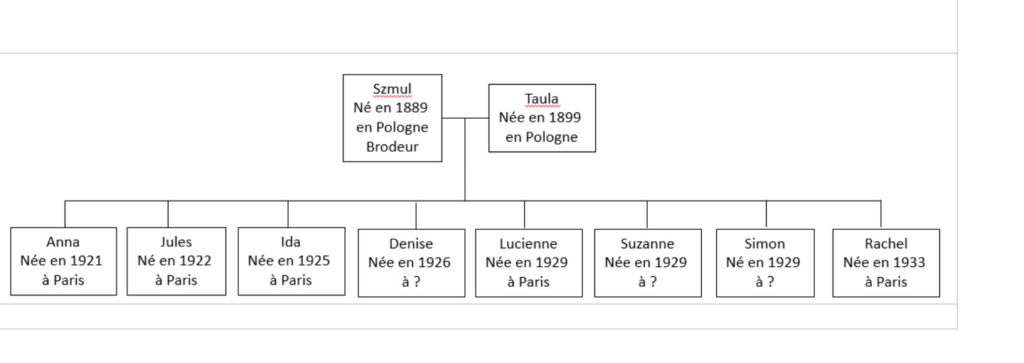
Notification of the granting of French nationality by naturalization.
Victims of Contemporary Conflicts Archives Division of the Ministry of Defense Historical Service.
Following Mr. Szmul Winterman’s application to be naturalized as a French citizen, the response from the Police Headquarters states that he was Polish, as were his wife and three of his children, in this case three daughters aged 4, 2 and 1, and that he had been living in France with his family since 1924, working and earning 2,000 francs a month.
His request for naturalization on was granted on February 4, 1930. The response states that “his application for naturalization may be granted”. This was the case for many Polish emigrant families in the neighborhood.
Lucienne as a schoolgirl
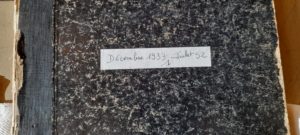 The register of the Eugène Reisz school (in the 20th district of Paris).
The register of the Eugène Reisz school (in the 20th district of Paris).
Archives de Paris.
This register shows that Lucienne Winterman went to kindergarten at the Eugène Reisz school. She left in July 1934, when she was in section 1.
One of the records in the school archives is the front page of the register, which lists Mrs. Direz as acting headmistress as of January 16, 1934. The school was at 2 rue Eugène Reisz, not far from our school.
The second part of the page shows, starting from the left-hand column, the numbers of the pupils enrolled, their surnames, first names, dates of birth, fathers’ first names, occupations and addresses. On the line referring to Doba Wintermann, we see that she was number 419 on the enrolment register, that she was born on March 19, 1927, that her father’s first name was Szmul Maraka, that he was an embroiderer, and that they lived at 6.B rue Terrier.
The Winterman couple had four daughters at the time of the notification of their naturalization on February 14, 1930. They were 9, 4, 2 and 1 years old. Only the last 3 girls were born in Paris and thus were French citizens. One of these girls was called Doba, the one who went to school on rue Eugène Reisz around 1934 and was born on March 19, 1927. She was therefore 2 years old when her father applied to be naturalized as a French citizen.
Naturalization review, carried out in 1943.
Victims of Contemporary Conflicts Archives Division of the Ministry of Defense Historical Service.
The Vichy government set out to remove French citizenship from people who had been naturalized. This archived letter to the Secretary of State for Justice, written on July 19, 1943 and received on July 21, 1943, shows that an investigation into the family was undertaken after the father died.
This is a notification from the Police Headquarters relating to the naturalization of Lucienne Winterman’s family as French citizens.
The pages have been signed and stamped. The first and last names of the Winterman family and their children are listed, along with their dates and places of birth, professions and places of work, addresses and nationalities.
It states that Smzul Winterman was born in Rososz, Poland, on May 22, 1889. He married a Polish woman and they had eight children, including two sons and six daughters. Three of them were born in Paris and were French citizens. Smzul Winterman had lived in France since 1924. He was a bespoke tailor: bespoke tailoring is a working arrangement in which a craftsman, who owns his own equipment, produces goods to order for a merchant who is then responsible for marketing them. His daughter Hana worked at the Basta workshops as a garment finisher. Chil was a fitter and Ida and Doba both went to a youth center on rue Vauquelin. The other children went to school.
Here are the family trees that we were able to put together from all this information:
A teenage girl in the inter-war period and during the war
Hitler and the Nazi Party had been in power in Germany since 1933. He enacted the anti-Semitic Nuremberg Laws in 1935, which were designed to “protect the Aryan race and German honor”. He set up concentration camps, encouraged a boycott of Jewish stores and mobilized the Hitler Youth. He also embarked on a rearmament plan for Germany, and founded the Gestapo and the SS. Taking advantage of the lack of action by the other democratic governments in Europe, he relocated to the Rhineland in March 1936. Lastly, he established the Rome-Berlin axis in 1936, by forming an alliance with Mussolini’s fascist and totalitarian Italy. Japan also signed the Anti-Comintern Pact with Germany, pledging to oppose the Communists. Italy joined the pact in 1937.
In Russia, in the former the USSR, Stalin’s communist regime began the “Great Terror” and fostered a culture of idol-worship around Stalin himself.
At around the same time, France was affected by the Great Depression of 1929 and, from the beginning of the 1930s, by rising unemployment. Unstable governments and a surge in far-right thinking brought the Popular Front party (PCF, SFIO and the Radicals) to power in the elections to the National Assembly in May 1936. Led by Léon Blum, the party introduced a number of social reforms, including wage increases, shorter working hours and paid vacations.
Finally, the Spanish Civil War wreaked havoc, with General Franco’s army at the helm.
Lucienne Winterman was born just a year before the Great Depression of ’29.
She lived in the 20th district of Paris, where many of the children were rounded up, including those from the Tourtille school. A large number of Jews lived in that area. We don’t know whether Lucienne was a practicing Jew, or whether she went to a synagogue such as the one in Belleville, which a few of us were able to visit during our trip to the neighborhood as part of the Shoah Memorial’s “Jewish lives in a working-class district – Belleville and the 20th district” workshop.
© Paco Guibert and Isaak Laporte-Galaa
We were lucky enough to meet Rachel Jedinak, who, like Lucienne, was a local child during the war. Her biography can be found on the website of the Comité “École de la rue de Tlemcen”, a non-profit organization dedicated to the memory of Jewish children deported from the 20th district of Paris.
She told us about her life as “much-loved” child during the war in our neighborhood between rue Duris, rue des Amandiers and the Père Lachaise cemetery.
“And then on October 4, 1940 there was the decree targeting Jews, and they were required to register themselves as Jewish. Well, look at me, I’m an old lady, I don’t have “Jew” written on my forehead, and never, never would the Germans, the Nazis have known where to find us if the French police hadn’t done their dirty work for them.”
A lot of people took part in the census because they were still not French citizens and wanted to remain legally resident in the “land of human rights”. That’s what Rachel’s father did. He was then arrested during the “Green Note round-up” on May 14, 1941 and deported on June 27, 1942.
Rachel Jedinak was arrested along with her mother during the Vel d’Hiv roundup. Even children were deported following this and the subsequent roundups. On the memorial stone behind the town hall in the 20th district of Paris are the names of a child who was only 19 days old, and another who was 4 months old. Rachel also recounts how children no longer wanted to play with her because “she was Jewish”. Rachel managed to avoid the Vel d’Hiv roundup, but also the roundup of February 11, 1943.
She was sent to the same UGIF home as Lucienne, the Lamarck center. Conditions were very strict, and she was allowed just two visits a month. She ran away from the home and hid in several different places.
Lucienne Winterman’s political deportee record states that she “attended the girls’ vocational school 16 rue Lamarck”, and that one of the witnesses to her arrest was Sarah Hoffnung, another girl whose biography we wrote two years ago.
Newborn children were deported because they came from a Jewish family. Some children saw their mother taken away to her death without even being able to kiss her one last time.
A document from Lucienne’s political deportee dossier.
Victims of Contemporary Conflicts Archives Division of the Ministry of Defense Historical Service
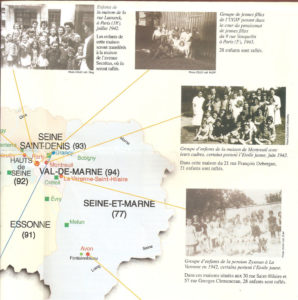 A page from “Comment on en arrive là ?” (“How did it come to this?”), Conseil régional d’Ile-de-France, dated January 27, 2004
A page from “Comment on en arrive là ?” (“How did it come to this?”), Conseil régional d’Ile-de-France, dated January 27, 2004
 Source: À l’intérieur du camp de Drancy (Inside Drancy camp) by Annette Wieviorka and
Source: À l’intérieur du camp de Drancy (Inside Drancy camp) by Annette Wieviorka and
Michel Laffitte. Perrin, 2012
Lucienne Winterman arrived at Drancy camp on July 22, 1944. Her registration number was 25,473. She was placed on stairway 6, first in room 4, and then in room 3.
The letter B denotes that she was to be deported immediately but in fact she stayed in Drancy for nine days before being deported to Auschwitz-Birkenau on Convoy 77 on July 31, 1944. She was just 16 years old. There were 324 children aboard Convoy 77, most of whom were murdered in the gas chambers as soon as they arrived in Auschwitz.
They had all been rounded up in and around Paris, Montreuil and La Varenne, mostly in children’s homes. Lucienne Winterman had stayed at the UGIF boarding school for girls at 9 rue Vauquelin in the 5th district of Paris, and at the Lamarck center in the 18th district. Her previous address was 6 rue Félix Terrier. Her parents probably placed her in the homes to keep her hidden.
Photos taken during our visit to Drancy camp. Stairway 6 is behind the trees.
From the Ministry of Veterans and Victims of War record dated September 1, 1956, we discovered that in late November 1944 she was transferred from Auschwitz-Birkenau to the Kratzau camp, from which she was liberated on May 11, 1945. On the second record, dated June 13, 1955, the “died on” box is left blank, which also confirms that she survived the Auschwitz-Birkenau camp. It also states that on June 13, 1955 (the date the on which the document was written), Lucienne’s address was 6 rue Félix Terrier, in the 20th district of Paris. She was repatriated via Sarrebourg and had moved back to her previous home.
Rosa and Sarah Hofenung, two other girls who, like Lucienne, came from our neighborhood, were also transferred to the Kratzau camp.
Kratzau was a sub-camp of the Gross-Rosen camp.
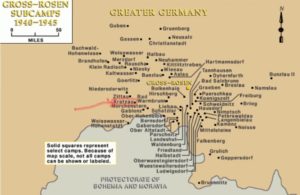 The Gross-Rosen concentration camp was founded in August 1940 as a sub-camp of the Sachsenhausen camp. It was named after the nearby village of Gross-Rosen (present-day Rogoznica), around 40 miles from Wroclaw (formerly Breslau) in western Poland. It became an independent camp in May 1941.
The Gross-Rosen concentration camp was founded in August 1940 as a sub-camp of the Sachsenhausen camp. It was named after the nearby village of Gross-Rosen (present-day Rogoznica), around 40 miles from Wroclaw (formerly Breslau) in western Poland. It became an independent camp in May 1941.
Gross-Rosen became the center of an industrial complex and the administrative hub of a vast network of at least 97 subcamps. On June 1, 1945, the Gross-Rosen complex held 76,728 prisoners, including almost 26,000 women, most of them Jewish. It was one of the largest concentrations of women in the entire Nazi concentration camp system.
According to our online research, Lucienne Winterman died on November 11, 2018, at the age of 90, in Israel, where she moved after the war. We have been unable to contact any of her family there.
Sources :
- Victims of Contemporary Conflicts Archives Division of the Ministry of Defense Historical Service (DAVCC).
- The Yad Vashem website.
- The book À l’intérieur du camp de Drancy, (Inside Drancy camp) by Annette Wieviorka and Michel Laffitte, published by Perrin in 2012.
- Se souvenir pour construire l’avenir (Remembrance to help shape the future) “Ecole de la rue Tlemcen” committee, published by Colombier.
- United States Holocaust Memorial Museum Encyclopedia
- Paris Archives


 Français
Français Polski
Polski